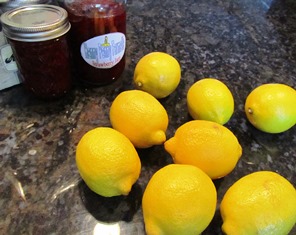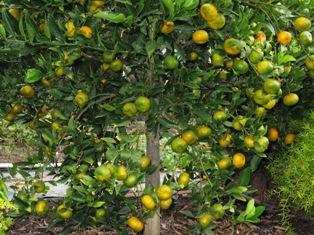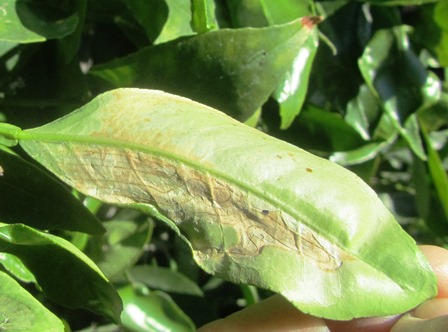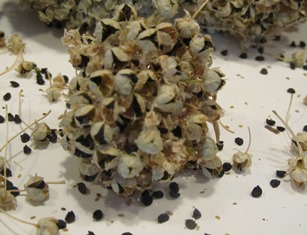Growing a Meyer Lemon Tree
Meyer Lemon is California’s favorite backyard fruit tree. Here, in the Bay Area, I am growing it on my farmette along with Satsuma tangerines, blood oranges, naval oranges, and lime trees. We love marmalade made from our citrus as well as juice, pickles, and desserts.
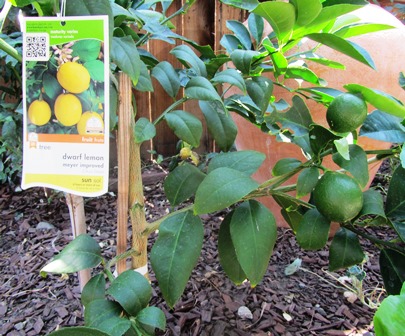
Leaving the tag attached for the first year can guide a gardener to caring for the plant according to grower recommendations
In two beds at the front of my property along a fence line, I’ve planted several citrus trees, among them, an improved Meyer lemon.
First introduced from China to the United States in 1908, Meyer Lemon takes its name from an agricultural explorer with the USDA named Frank Nicholas Meyer. These beautiful thin-skinned lemons are more round, juicier, and less acidic than their counterparts Lisbon and Eureka. It takes four years to grow one tree from seed. Today, the improved Meyer is widely available in California.
In the 1940s, Meyer lemons were believed to be carriers of the Citrus tristeza and tatter leaf viruses. Although these viruses did not harm the Meyers, it harmed other varieties of lemons grown by commercial growers. Ergo, the California department of Food and Agriculture dictated that the Meyer lemons would have to be eradicated. See, https://en.wikipedia.org/wiki/Meyer_lemon
In the 1950s a virus-free selection was identified and then in 1975, an improved Meyer was cloned. It tested free of those viruses, resulting in this new, “improved” Meyer Lemon again being planted in California. If you love the bright flavor and the clean, fragrant scent as well as the versatility of this lemon that can be roasted, salted in brine, drizzled into cake, made into pie, and even candied, consider planting an improved Meyer Lemon tree. They are vigorous growers that produce a bountiful crop.
Six Steps to Growing a Meyer Lemon
1. Plant in a container (the method many Chinese gardeners love) or in the ground.
2. Dig in a south-facing spot that will receive plenty of sunlight (at least eight hours per day).
3. Water when needed, but don’t over-water; this citrus likes a good drenching and then a chance to dry-out.
4. Four times per year, apply organic citrus fertilizer and water it into the roots.
5. Give support to young trees against wind, and thin fruit on young trees until they are are well established.
6. Prune off branches after the late winter/spring harvest to keep them (or the fruit) from touching the ground.
Leafminer Larvae Can Destroy Young Citrus Trees
The new leaves on nearly all our citrus trees show signs of the presence of the citrus leafminer. The local garden center representative explained this pest is ravaging trees in our area. The pest’s name is fitting–its larvae tunnel into new leaves creating mining tunnels.
This pest came to California in 2000 by way of Florida, where it showed up in 1993 and began steadily moving westward. The citrus leafminer is native to Asia, but in the 1940s, it showed up in Australia. From there, it began to appear in other citrus-growing regions of the world.
The citrus leafminer is a small, light-colored moth. Its forewings are irridescent. The wing tips have a black spot. The hind wings and its body are white. Look for a serpentine tunnel on a new leaf and inside the tunnel is thin dark line, the frass (or feces) trail.
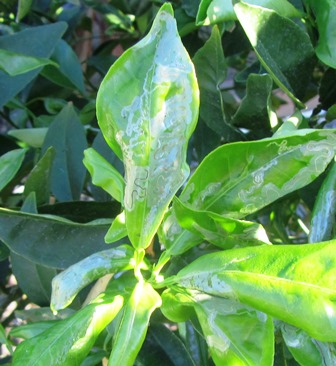
The citrus leafminer burrows into new leaves, creating tunnels that, in turn, make for an exotic mosaic appearance on the leaves
In its last stage before adulthood, the larva causes the leaf the curl up. The curling is the result of the larva rolling the leaf end around itself in order to pupate as it becomes an adult moth.
Older, hardened citrus leaves are not at risk. The citrus leafminer attacks only young, shiny, green, new leaves. Young trees are perhaps at greatest risk.
Citrus growers should prune their trees only once each year because pruning causes a flush of new growth, open for attack. Because of the difficulty of getting the product inside the tunnels, chemical control is not recommended. Also, traps using a pheromone attracts only the male moth. It gets stuck inside, but this won’t eliminate the citrus leafminer population.
Biological control is accomplished through parasites and predators. The non-stinging wasps, Cirrospilus and Pnigalio species are particularly effective against citrus leafminer since the parasites lay eggs inside the leafminer tunnels, either inside or on the top of the citrus leafminer larvae. The parasite egg hatches and the parasite larvae eat the leafminer larva. You don’t have to put these pests in your garden. They are attracted to citrus just like the leafminer is.
Nature has a powerful checks-and-balance ecosystem that works best when growers do not spray insecticides. Pesticides and insecticides disrupt predator activity and nature’s inherent balance.
Salivating Over New Organics from Old and Rare Seed
What I love most about the onset of winter is the arrival of the seed catalogs. Armed with the newest one, I enjoy sitting on the porch, warming my bones under the pale winter sun, and reading about what I could be growing on the Henny Penny Farmette this spring–like the onions from rare, old seed that Bountiful Gardens offers in its 2014 catalog.
Bountiful Gardens is a nonprofit organization located in Willits, California (160 miles north of San Francisco). The organization has signed the Safe Seed Pledge and promises to never knowingly buy or sell seeds that are GMO (genetically modified).
The onion seed I’m eager to purchase is the Mill Creek Red Onion–a special heirloom I read about that is considered to be bolt-resistant and grows well in spring or fall. According to the catalog, the onion was bred by nursery owners Joe and Wanda Turi, who have since passed away. Thanks to the folks at Bountiful Gardens, a box of the Turi’s onions was acquired, ensuring the rare seed would be preserved and multiplied in gardens like mine and yours.
Another vegetable I want to try is the Early Purple Sprouting broccoli, a European heirloom that grows into a large plant with purple heads possessing excellent nutritional value and flavor. An August planting is recommended because the plant needs to survive through a winter to become productive.
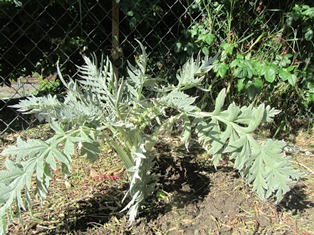
I managed not to kill the artichoke I planted last year and, thus encouraged, I would like to grow some other varieties
The artichoke (cynara cardynculus) listing in the catalog also intrigues me. The plant won’t produce chokes during its first year, but I don’t mind. Having an abundance of chokes for farmette meals makes me want to send for the seed right now. Don’t even get me started on all the herbs I want to order and plant! I might have to turn the farmette into a farm.
The Bountiful Gardens 2014 catalog is one of the best. Not only are the listings intriguing to read, the full-color pictures are nothing short of seductive for a gardener. Offerings include heirloom, open-pollinated, untreated seeds for sustainable growing of vegetables, grains, oil and forage crops, wild trees and shrubs, berries, herbs, and flower. The catalog even offers mushroom spawn. There are also books and media products available on gardening topics, composting, permaculture, self-sufficiency, garden pests, tools, seed saving, and much more.
If you are interested in getting your own copy of the 2014 catalog, write to Bountiful Gardens, 18001 Shafer Ranch Road, Willits, CA 95490; phone 707-459-6410. Or email: bountiful@sonic.net. See, http://www.bountifulgardens.org
 Facebook
Facebook Goodreads
Goodreads LinkedIn
LinkedIn Meera Lester
Meera Lester Twitter
Twitter


